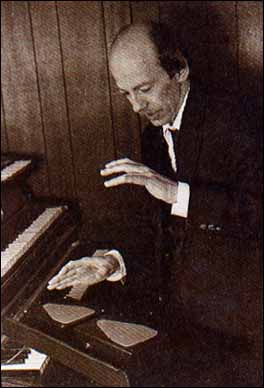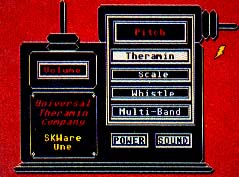ON DISK!
The ST THEREMIN
START's Eerie Sound Generator
BY STERLING K. WEBB
The theremin is famous for producing the wailing, eerie sounds that have become synonymous with science-fiction cinema. Inspired by the classic Forbidden Planet, SEURAT author Sterling Webb developed his version of the theremin for the ST. ST Theremin runs in all three resolutions.
Make synthesized sound the old-fashioned way. File THEREMIN.ARC on your START disk.
 |
| With a wave of his hand. . .he makes music. There- min virtuoso Eric Ross is shown playing a modern- ized digital version of the eerie-sounding instrument that originated in 1924. With the ST Theremin, you can make the same kinds of sounds with your ST. |
The theremin--a buzzing, humming box of haunting sounds invented in 1929 by the Russian engineer Leo Theremin--was the first instrument to generate music electronically. It produced tones that were actually synthesized rather than modified and amplified from sounds produced by traditional physical means such as plucking a string, banging a drum or hooting into a hollow tube. It's the true ancestor of whole generations of electronic instruments.
The original theremin sported two wands, or antennas--one horizontal and one vertical. The thereminist moved, waved, flapped, fluttered and wobbled both hands around these wands to produce the eerie hums and buzzes that were to be the instrument's trademark. The capacitance (electric charge) of human hands controlled the pitch and volume of the theremin, and the thereminist's odd motions wove a song into the air.
In 1956, the theremin reached its largest audience ever. That year it was used to produce the complete soundtrack of the science-fiction movie epic, Forbidden Planet. The theremin created all the sounds needed by the movie, from the weird revolving hum of the flying-saucer-like starship to the tinkling waterfall in a garden.
Getting Started
ST Theremin emulates the theremin on the ST. The mouse replaces the human hand, controlling volume by its vertical position and pitch by its horizontal position. You'll be amazed at how simple it really is.
To run ST Theremin, copy THEREMIN.ARC and ARCX.TTP onto a blank, formatted disk and un-ARC THEREMIN.ARC following the Disk Instructions found elsewhere in this issue. The program was written in GFA BASIC and runs in all three resolutions.
At the Desktop, double-click on THEREMIN.PRG and you're there. Turn up the volume on your monitor and move the mouse around the screen--you'll get a kick out of all the crazy sounds emanating from your monitor speaker. Move the lightning-bolt cursor up for louder sounds and down for lower volume. Move the cursor to the right to raise the pitch and move it left to lower it. What's that sound? Are flying saucers landing in the backyard?
 |
The ST Theremin screen. Use your mouse to move the lightning-rod cursor up and down the screen to increase the volume or back and forth to change the pitch. It's fun-- and it will annoy your neighbors! |
The Controls
This is a second-generation, solid-state theremin, so there are four pitch/scale options.
The Theremin mode is active when you load the program. Click on Scale to break the continuous tones of the theremin mode into the stepped notes of a scale. Whistle reads pitch from the mouse in a logarithmic scale, producing tones like those of a slide whistle. The Multiband mode zones the screen into eight separate theremins ranged along the horizontal axis. Test them all for yourself.
The SOUND button lets you turn off tone generation, just in case you have to leave your ST for a minute (or your ears need a rest). Click on SOUND again to restore the sound. Click on POWER to return to the Desktop, but be ready to jump when you do (don't say I didn't warn you!).
Wrap-Up
So the next time you're looking for some funky sounds try the ST Theremin. It'll let you make all the noise you need.
Sterling K. Webb lives and works in Bunker Hill, Illinois. He wrote SEURAT, the popular draw-and-paint program published in the March 1989 issue of START.